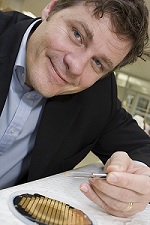 |
| Vaxxas' nanopatch needle-free delivery system--Courtesy of Vaxxas |
Australian nanopatch developer Vaxxas signed on with the World Health Organization this week in an effort to co-opt the company's patch for use with the polio vaccine. The WHO will help fund the research and move it through preclinical and clinical studies as the organization seeks to make polio a thing of the past.
Vaxxas' transdermal delivery system incorporates a small patch containing an array of vaccine-coated microprojections that perforate the outer layers of skin, releasing the vaccine to the immune cells below the skin's surface. This needle-free approach has long been sought after but has suffered due to trouble with scaling on the manufacturing side--a problem Vaxxas says it has solved with its simple design.
And for polio, the advanced delivery method could help approach the goal of complete eradication. The paralyzing childhood disease that once posed a serious health threat worldwide underwent a 99% reduction in incidence toward the end of the century as vaccination became more prominent, but Vaxxas notes that 350,000 cases in 125 countries still persisted as late as 1988. Getting to the remaining cases would require a delivery method that goes beyond a simple jab and the crippling "cold chain."
 |
| Vaxxas CEO David Hoey |
"The nanopatch doesn't need to be kept refrigerated to maintain its efficacy--a tremendously important factor for the transportation and application of polio vaccine in the remote regions of the world where eradication efforts are more challenging," Vaxxas CEO David Hoey said in a statement. "The research we are undertaking with WHO's support aims to provide better vaccine solutions to all children anywhere with this life-saving health intervention."
Vaxxas is riding a wave of needle-free advances that market research firm Frost & Sullivan said this month would gain serious traction in the next 5 to 10 years. Merck ($MRK) in 2012 presented Vaxxas with a three-year grant to further develop its platform. And back in 2011, the company collected $16.3 million in venture capital to get its technology off the ground.
The Brisbane, Queensland-based operation also has a commercialization office in Cambridge, MA.
- here's the release
Special Report: The Future of Nanotech Drug Delivery - Nanopatch for more effective vaccination